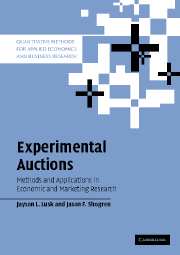Book contents
- Frontmatter
- Contents
- List of figures
- List of tables
- 1 Introduction
- 2 Incentive compatible auctions: theory and evidence
- 3 Value theory
- 4 Conducting experimental auctions: some preliminaries
- 5 Conducting experimental auctions
- 6 Data analysis
- 7 Valuation case studies
- 8 Auction design: case studies
- 9 Validity of experimental auctions
- 10 The future of experimental auctions
- References
- Index
4 - Conducting experimental auctions: some preliminaries
Published online by Cambridge University Press: 27 October 2009
- Frontmatter
- Contents
- List of figures
- List of tables
- 1 Introduction
- 2 Incentive compatible auctions: theory and evidence
- 3 Value theory
- 4 Conducting experimental auctions: some preliminaries
- 5 Conducting experimental auctions
- 6 Data analysis
- 7 Valuation case studies
- 8 Auction design: case studies
- 9 Validity of experimental auctions
- 10 The future of experimental auctions
- References
- Index
Summary
Introduction
In this chapter, we address some broad issues worth considering before starting off on the path of choosing specific auction parameters. Perhaps the most important initial step in any project is to define the study objectives. What are the goals of the analysis? What are the testable hypotheses? Who is the intended audience? Answering these questions will necessarily dictate many of the resulting design choices. A study that aims to test a particular behavioral or economic theory might require a significantly different design than one that aims to estimate the welfare effects of a new technology or to inform new product design. For example, a common complaint of experimental studies is that students are frequently used as subjects. The veracity of this criticism, however, depends on the nature and type of study. A theory is a generalization that should hold for everyone, including students. As stated by Noussair, Plott, and Riezman (1995, p. 462):
Since the world's international economies are vastly more complicated than the economies created for this study, of what relevance are laboratory-generated data? The answer is that laboratory experiments are not attempts to simulate field situations, as the question of the skeptic seems to presume. Laboratory research deals with the general theories and the general principles that are supposed to apply to all economies, the economies found in the field as well as those created in the laboratory. The laboratory economies are very simple and are special cases of the broad class of (often complex) economies to which the general theories are supposed to be of relevance.[…]
- Type
- Chapter
- Information
- Experimental AuctionsMethods and Applications in Economic and Marketing Research, pp. 46 - 61Publisher: Cambridge University PressPrint publication year: 2007



